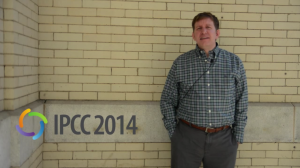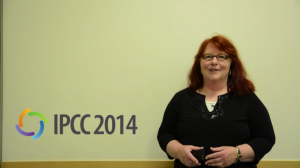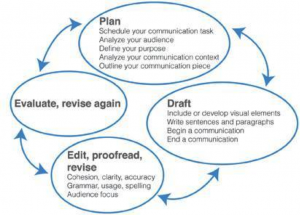Understanding the communication process is essential to becoming an effective professional communicator. This page lists resources we’ve curated and developed on the engineering communication process.
Audience Analysis as Part of a Strategic Communication Framework
Understanding your audience often discussed as one of the most important steps of the communication process; however, it is often the least well practiced and understood stage as well, largely because most documents (or other forms of communication) have multiple audiences, with multiple needs. In her Strategic Communication Framework, Debbie Davy proposes a novel method for categorizing your potential audiences that may be helpful in understanding the kinds of attitudes and needs you’ll need to take advantage of as well as to overcome in planning your communication.
‘What’ are my team members? Getting engineers to see the ‘who’: Part Two
In her last post, Patricia Sheridan spoke about engineers’ and engineering students’ bias towards seeing ‘what’ their team members produce as opposed to ‘who’ their team members are and ‘how’ they can contribute to making the team and the product better. Teams that only see the ‘what’ eventually fall apart or produce suboptimal work that no team member is proud of. Getting engineers to see and value ‘who’ their team members are is necessary to get team communication to a level where the whole team can be greater than the sum of its parts. This post explores three key practices to effectively cultivate the ability to see ‘who’ your team members are.
Emotional Intelligence and Engineering Communication
|
Dr. Alex Ilyasova, Director of the Professional and Technical Writing Program at the University of Colorado, Colorado Springs, defines emotional intelligence and describes the important role that it plays in engineering work, particularly in communication within teams. Her research on this topic was delivered at the IEEE PCS Conference in Limerick, Ireland in July 2015. See her video interview here.
|
 |
Should Organizations Adapt their Writing Style in Documents for International Audiences?
International organizations need to communicate with stakeholders with diverse cultural backgrounds. Different cultures have different values, which may have implications for how messages are evaluated across cultures. Different cultural values may lead to different stylistic preferences. Does this mean that organizations need to adjust their writing styles to appeal to different audiences?
Knowing how to address your customers across different cultures is key. Hendriks and colleagues’ “Style Congruency and Persuasion: A cross-cultural study into the influence of differences in style dimensions on the persuasiveness of business newsletters in Great Britain and the Netherlands,” published in the June 2012 issue of the IEEE Transactions on Professional Communication [1], investigated reader reactions in UK and the Netherlands to differently styled business-to-business newsletters in terms of comprehensibility, attractiveness of the newsletter and intention to order goods. Read about their research, and what it might mean for your communication practices, here.
Podcast: Engineering Success Through Better Communication, with Anthony Fasano
In this podcast, we discuss the role that communication skills play in determining success for engineers with Anthony Fasano, author of the IEEE-Wiley series book, Engineer Your Own Success: 7 Key Elements to Creating an Extraordinary Engineering Career, and strategies for improving communication skills in various formal and informal workplace scenarios. Anthony is also the brains behind The Engineering Career Coach, a site rich with resources on engineering a successful engineering career. In this podcast, we discuss where communication skills matter in your engineering career, strategies for better listening as a foundation for better communication, along with ways to improve communication through email, oral presentations (formal and informal), and written reports. Access the podcast here.
International Virtual Teams: Engineering Global Success
Virtual teams have become essential to the success of global organizations. These are teams that rely more heavily on computer-mediated communication than face-to-face communication to support their work. In fact, international virtual teams are the key to some of the biggest successes and failures in the global workplace, and when they are functioning effectively, organizations reap large benefits. Among 285 engineering professionals who participated in a 2013 survey, 68% reported experiencing communication problems in their virtual teams, and many of these professionals emphasized the costs of miscommunication in virtual teams. Sixty percent of these professionals reported that their organizations provided no formal training to prepare employees to work in virtual teams. Another 17% reported that their companies provided some formal training but with limited success. Instead, most of these professionals confessed to learning by trial and error, a very costly organizational approach. In this webinar, Dr. Pam Estes Brewer presents 15 core concepts for launching and maintaining highly functioning international virtual teams, developed through research in engineering and many years of experience working in virtual teams. Access the recorded webinar here .
‘What’ are my team members? Getting engineers to see the ‘who’
For most engineers, teamwork is an important skill that is key to success in industry, but one that is not often taught or even explicitly addressed. Educators like Patricia Sheridan are trying to change that: her work focuses on engineering student design teams, but what she has found is relevant to all practicing engineers. In this series of three columns, she explores the concept of moving beyond the conventional understanding of team members as their contributions, and understanding them as people, as a way of improving team communication and performance. Read her first piece, on why we need to see the “who” in the team members, here.
Lessons from Academia in Developing English Language Skills and Training Programs
Many engineering schools, both in English speaking and non-English speaking countries, have had to come up with strategies for improving the English language abilities of their students. Schools in predominantly English speaking countries with increasing non-domestic enrolments have begun to see the importance of language support for student success. And given the developing role of English as the lingua franca in a global economy, many universities in non-English language speaking countries have begun instituting English language training into curricula otherwise conducted in a foreign language. Their experiences shed some light on key practices for successful language learning and language learning programs for engineers, which
In “Seeking an Effective Program to Improve Communication Skills of Non-English Speaking Graduate Engineering Students: The Case of a Korean Engineering School,” published in the March 2014 issue of the IEEE Transactions on Professional Communication [1], E.G. Kim and A. Shin examine the necessity and challenges of developing English language skills and training programs within the context of a Korean engineering school. Three of their key findings have strong implications for both those learning and teaching the language: read about them in this post.
Principles for Reuse: How to Repurpose Documentation for Different Situations
Professional communication often involves producing documentation for slightly different contexts, sometimes over the course of multiple years. Information about the same product, process, or event is often delivered to different audiences and to meet different purposes. Product specifications might need to be developed for an engineer working on its redesign, or a marketer developing consumer facing product information. And over time, information can change as understandings or contexts evolve: the understanding of an engineering failure, for example, could change as new methods for interpreting available data arrive. Because of this, reuse and revision is essential to the development of an efficient writing process, both for individuals and across members of an organization.
But recycling content well requires a deep understanding of the material, the rhetorical situation, as well as how to repurpose. Spinuzzi et al’s “Remaking the Pitch: Reuse Strategies in Entrepreneurs’ Pitch Decks,” to be published in the May 2015 issue of the IEEE Transactions on Professional Communication [1], explores the processes and principles behind effective reuse of professional communication, specifically in the context of entrepreneurs reusing materials from their own documents and feedback from stakeholders in making competitive pitches. Read a summary of their upcoming IEEE Transactions on Professional Communication article, including a list of ways to think about reusing material in this post.
Günther Schreder: “Improving Self-Service Technologies through User-Centered-Design”
In a brief summary of their Joenk prize winning IEEE Transactions on Professional Communication article, Günther Schreder describes how thinking about your audience can be pivotal not only in the writing process, but in the design process as well, focusing on self service technologies such as automated ticket vending machines. The parallels between the communication and design processes become clear here as they describe their motives and methods. If you’re interested, the full article is also available here.
Dr. Richard House on Developing Engineering Credibility
|
Dr. Richard House, co-author of the Lufkin award winning paper on engineering ethos in environmental public policy deliberations, tell us about the case they studied, and what it tells us about how engineering argument and authority is often constructed in this interview. Find out about what helps to constructs credibility in these and other contexts.
|
 |
Bernadette Longo on What Interdisciplinarity Means for Professional Communication
|
Dr. Bernadette Longo gave the closing keynote at IEEE PCS 2014 conference on Disciplinary Grounding and Interdisciplinary Understanding. We asked her a few questions about the challenges and opportunities this increasing interdiscipinarity presents for professional communication. See her answers in this interview.
|
 |
Use a Communication Development Process
|
To ensure your audience understands what you want to communicate, you will want to adopt a communication development process. Adhering to a defined process, such as the one pictured below, can make your communication tasks more efficient and effective. Learn about using a Communication Development Process here.
|
 |
Audience, Purpose, Context
As a professional engineer, you may be expected to communicate in myriad ways. You’ll write updates on a project via email; you’ll give formal presentations to a lay audience; you’ll write a report for an expert audience; and much more. All of these communication situations require different strategies in order to be successful.
Find out why you should identify and analyze your audience, purpose, and the context surrounding your situation. Visit the links below to learn how to:
- Understand Your Audience
- Identify Your Purpose
- Identify the Context surrounding your communication situation
Podcast: Establishing Effective Communities of Practice (CoP)
Jon Scharer introduces us to Communities of Practice (CoP) in this podcast. Communities of Practice, both for management and practitioners, have, for a variety of reasons, become more valued of late in the workplace. Listen as Scharer highlights two key factors necessary for ensuring the establishment and maintenance of an effective CoP.

